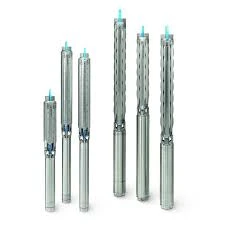Oct . 11, 2024 10:17 Back to list
immersible pumps
Understanding Immersible Pumps An Essential Tool for Various Industries
Immersible pumps, often referred to as submersible pumps, are specialized types of pumps designed for moving fluids from a submerged position. These innovative machines play a vital role in various industries, including agriculture, construction, mining, and wastewater management. Their versatility, efficiency, and effectiveness make them a preferred choice for numerous applications. In this article, we will explore the features, advantages, applications, and maintenance of immersible pumps.
Key Features of Immersible Pumps
Immersible pumps are characterized by their unique design, which allows them to operate fully submerged in the fluids they are meant to pump. To achieve this, they come equipped with a motor that is hermetically sealed to prevent water ingress, ensuring reliable and safe operation. The primary components of an immersible pump include the impeller, diffuser, and motor. The impeller is responsible for creating flow, while the diffuser helps to convert kinetic energy into pressure, facilitating fluid transport.
One of the hallmark features of immersible pumps is their ability to handle a wide range of fluids, including clean water, wastewater, and even abrasive slurries. This flexibility is largely due to the materials used in their construction, which can include corrosion-resistant alloys and high-density plastics designed to withstand the rigors of different environments.
Advantages of Using Immersible Pumps
The benefits of immersible pumps are vast
. Firstly, their design allows them to operate efficiently at varying depths, making them suitable for applications in deep wells, septic tanks, and underground storage tanks. Additionally, immersible pumps are generally quieter than their surface-mounted counterparts, providing a more favorable working environment in sensitive applications.Another significant advantage is their energy efficiency. Submersible pumps reduce the need for lengthy suction lines, which often suffer from friction losses, thus improving overall efficiency. Furthermore, they can be designed to operate on solar power or other renewable energy sources, aligning with the growing trend towards sustainability in industrial practices.
immersible pumps

Applications of Immersible Pumps
Immersible pumps find applications in numerous fields. In agriculture, they are commonly used for irrigation systems, enabling the efficient movement of water from wells or reservoirs to fields. In construction, these pumps manage water around excavation sites, helping to prevent flooding and ensuring the safety of workers.
In the mining industry, immersible pumps are essential for dewatering operations, keeping mines dry and operational. In the realm of wastewater management, they play a crucial role in the treatment process, transporting sewage and wastewater to treatment facilities.
Maintenance of Immersible Pumps
Although immersible pumps are robust and designed for endurance, regular maintenance is essential to ensure longevity and optimum performance. Routine inspections should include checking the electrical components, seals, and impeller for wear and tear. Any signs of damage or decreased performance should be addressed immediately to prevent larger failures and costly downtime.
Additionally, proper installation is crucial. The pump should be positioned in a manner that prevents it from drawing in debris, which can clog the impeller and reduce efficiency. Following manufacturer guidelines for installation and operation will help in maintaining the pump's performance over time.
Conclusion
Immersible pumps are integral to a multitude of industries, providing reliable, efficient, and versatile fluid management solutions. Their ability to operate effectively in various environments while remaining energy-efficient makes them indispensable in modern applications. As industries continue to evolve and embrace more sustainable practices, immersible pumps will undoubtedly remain at the forefront of fluid dynamics technology, adapting and improving to meet future demands. Understanding their features, advantages, applications, and maintenance requirements is essential for any organization that relies on effective fluid management solutions.
-
Submersible Water Pump: The Efficient 'Power Pioneer' of the Underwater World
NewsJul.01,2025
-
Submersible Pond Pump: The Hidden Guardian of Water Landscape Ecology
NewsJul.01,2025
-
Stainless Well Pump: A Reliable and Durable Pumping Main Force
NewsJul.01,2025
-
Stainless Steel Submersible Pump: An Efficient and Versatile Tool for Underwater Operations
NewsJul.01,2025
-
Deep Well Submersible Pump: An Efficient 'Sucker' of Groundwater Sources
NewsJul.01,2025
-
Deep Water Well Pump: An Efficient 'Sucker' of Groundwater Sources
NewsJul.01,2025
-
 Submersible Water Pump: The Efficient 'Power Pioneer' of the Underwater WorldIn the field of hydraulic equipment, the Submersible Water Pump has become the core equipment for underwater operations and water resource transportation due to its unique design and excellent performance.Detail
Submersible Water Pump: The Efficient 'Power Pioneer' of the Underwater WorldIn the field of hydraulic equipment, the Submersible Water Pump has become the core equipment for underwater operations and water resource transportation due to its unique design and excellent performance.Detail -
 Submersible Pond Pump: The Hidden Guardian of Water Landscape EcologyIn courtyard landscapes, ecological ponds, and even small-scale water conservancy projects, there is a silent yet indispensable equipment - the Submersible Pond Pump.Detail
Submersible Pond Pump: The Hidden Guardian of Water Landscape EcologyIn courtyard landscapes, ecological ponds, and even small-scale water conservancy projects, there is a silent yet indispensable equipment - the Submersible Pond Pump.Detail -
 Stainless Well Pump: A Reliable and Durable Pumping Main ForceIn the field of water resource transportation, Stainless Well Pump has become the core equipment for various pumping scenarios with its excellent performance and reliable quality.Detail
Stainless Well Pump: A Reliable and Durable Pumping Main ForceIn the field of water resource transportation, Stainless Well Pump has become the core equipment for various pumping scenarios with its excellent performance and reliable quality.Detail
